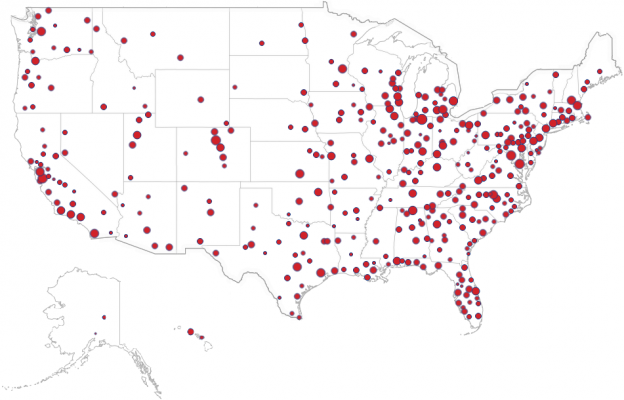By Maureen Book, Research Analyst, SelectUSA
SelectUSA recently released its second industry-focused report: “High-Tech Industries: The Role of FDI in Driving Innovation and Growth.”
This report provides an in-depth look at high-tech clusters in the United States and gives the first-ever analysis of the role of foreign direct investment (FDI) in high-tech industries. The report’s biggest takeaway is that FDI plays a significant role in these industries.
Where Are High-Tech Clusters?
High-tech industries are defined as employing more than twice the concentration of science, technology, engineering and mathematics (STEM) workers compared to the national average. After analyzing the U.S. high-tech industry and considering the participation of both foreign and domestic firms, SelectUSA explored the geography of high-tech companies in the United States by state, to identify large groups, or clusters, of employment. The top employers of high-tech workers were California, Texas and New York, while the District of Columbia, Virginia and Washington boast the highest employment per capita of high-tech jobs.
High-Tech Clusters by Metro Area
Looking at metro areas with the highest concentration of high-tech employment, SelectUSA found that San Jose, Calif., tops the list with more than 34 percent of local employment in high-tech industries. It was followed closely by Elkhart, Ind., with nearly 33 percent, and Huntsville, Ala., with over 31 percent.
While the concentration in San Jose might not be surprising because it is the largest city in the Silicon Valley, Elkhart and Huntsville both have industry concentrations nearby to make them important locations for high-tech companies. Elkhart’s economy is heavily concentrated in the transportation equipment manufacturing industry and centers around recreational and commercial vehicle manufacturing. While Huntsville is home to many military technology firms and aerospace and defense contractors.
The Role of Foreign Direct Investment (FDI)
Using our definition of high-tech industries and data published by the Bureau of Economic Analysis, SelectUSA looked at the role that FDI plays in high-tech industries. FDI generally involves not only monetary investment, but the management of a company by a foreign enterprise. To be considered FDI, the investment must usually be linked with the real output of the country in which it operates.
Our data found that FDI stock in high-tech industries reached over $1.6 trillion in 2016 and supported 2.1 million jobs in the United States. In fact, the high-tech component of FDI is quite robust – nearly 44 percent of all FDI in the United States is invested in high-tech industries.
Compensation, R&D, Exports and Value-Added Activities
Beyond employment, FDI in high-tech sectors has other significant contributions to the U.S. economy.
The U.S. affiliates of foreign-owned firms typically offer higher wages compared to domestic firms. In addition, companies engaged in FDI in high-tech industries offer higher average pay compared to FDI companies in other industries – more than $101,000 per worker.
U.S. affiliates of foreign-owned firms in the high-tech sector also spend nearly $42 billion on research and development (R&D). In 2015, they also contributed $154 billion towards U.S. goods exports and more than $373 billion towards value-added activities.
Source Markets Supporting High-Tech
We also find that Germany, the United Kingdom, France, and Japan are among the largest source markets for R&D spending, exports and value-added activities in high-tech industries. Beyond that, they are also the US’s traditional trading partners. Collaborating with them on FDI reinforces our trade relationships and strengthens the US’s bilateral ties with these partners.
For more information
Please visit SelectUSA.gov to view the full report, other industry reports, international and domestic FDI fact sheets and SelectUSA’s data visualization tool, SelectUSA Stats.


